The Man Out of Time was defrosted six decades ago…
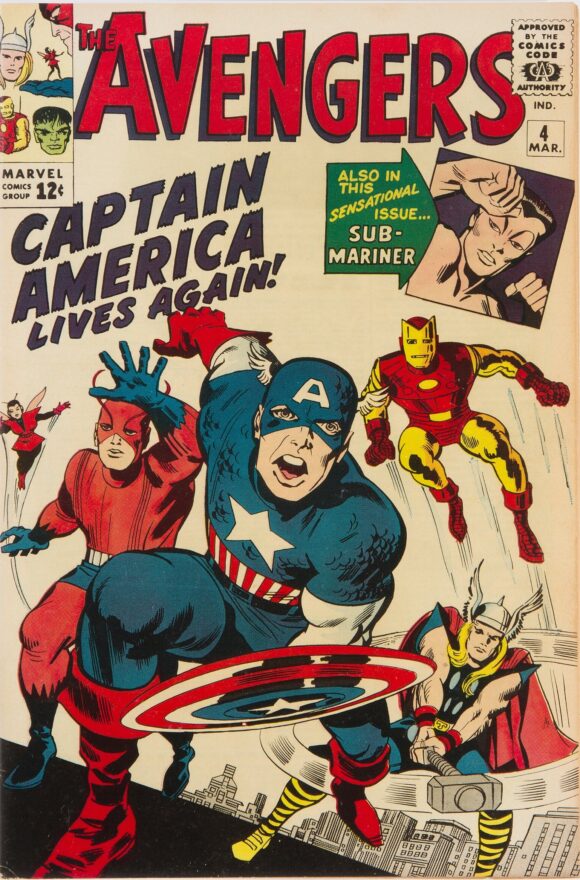
Jack Kirby pencils, George Roussos inks
By PETER BOSCH
I was a child of 8 when The Avengers #4 came out on January 3, 1964 (with a cover date of March 1964). I had already become a major fan of the colorful heroes of DC by this time, with Superman leading the way, and I was also picking up some Marvel titles such as The Amazing Spider-Man and Fantastic Four, but none of the Marvel books held that much interest for me as the ones from DC did. I was there from The Avengers #1 and I have to say that even when I read the second issue (the one with the Space Phantom), I felt the title wouldn’t last long. Something was needed in order to capture my interest. How little was I to know that just two issues later, The Avengers would head my Marvel reading list and that the hero re-introduced there would become my second favorite costumed adventurer, just behind the Man of Steel!
Of course, I am speaking of Captain America. What attracted to me to the fighting warrior from World War II was likely his star-spangled, red, white, and blue flag-like costume. I had not at the time seen the Strange Tales #114 (Nov. 1963) issue in which the villainous Acrobat disguised himself as Cap to fool people so he could pull off a heist, going up against the Silver Age Human Torch. Maybe now, I am glad that I didn’t as it may have affected my seeing the real Cap for the first time in The Avengers #4. (Stan Lee ended that Strange Tales Human Torch story by suggesting that he wanted to see if readers were interested in seeing the real Cap brought back.)

Kirby pencils, Dick Ayers inks
When I clutched The Avengers #4 in my little hands I was holding solid gold. There he was, Captain America, dynamically leading the Avengers forward on that eventful cover. And his military training would quickly provide a leadership position over this group of independent-leaning heroes, so much so that when the original group decided to go back on their own in The Avengers #16 (May 1965), they thrust the commanding role onto Cap, where he would lead three recruits who had been regarded as bad guys when they made their first appearances (Hawkeye, Quicksilver, and the Scarlet Witch).

Kirby pencils, undetermined inker
But I am jumping way ahead of myself. Let’s get back to The Avengers #4:
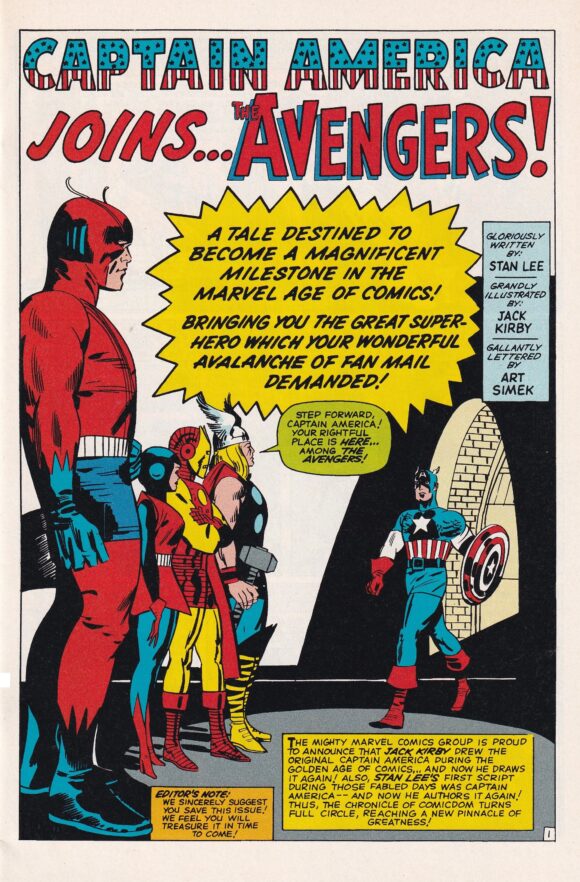
In that fateful issue, the Avengers (Iron Man, Thor, Giant-Man and the Wasp) are heading home after a battle at Gibraltar in the third issue against their former teammate, the Hulk, who had deserted the team at the end of Issue #2 and joined forces with Namor, the Sub-Mariner, in #3. While our heroes were on their return trip in their deep-sea jet bathyscaphe (provided by Tony Stark, of course) through the Gulf Stream, they see the rigid body of someone in the water.
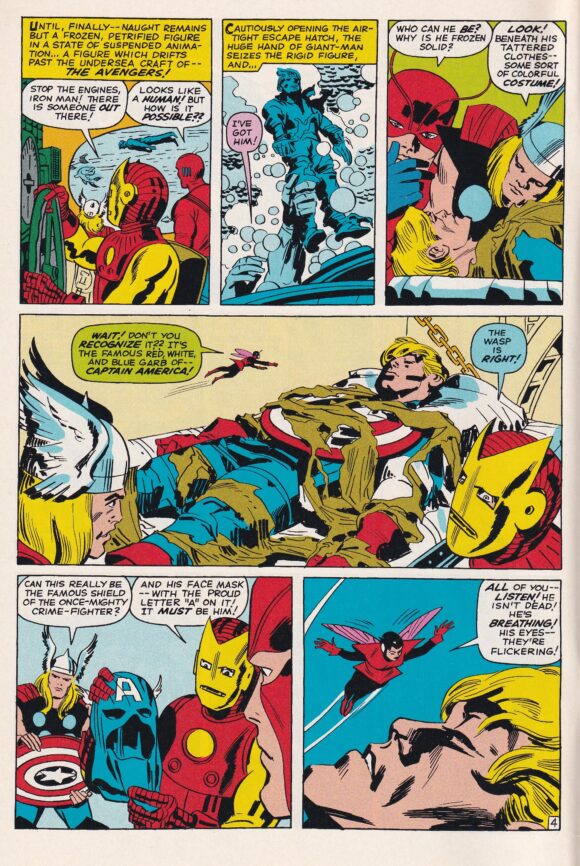
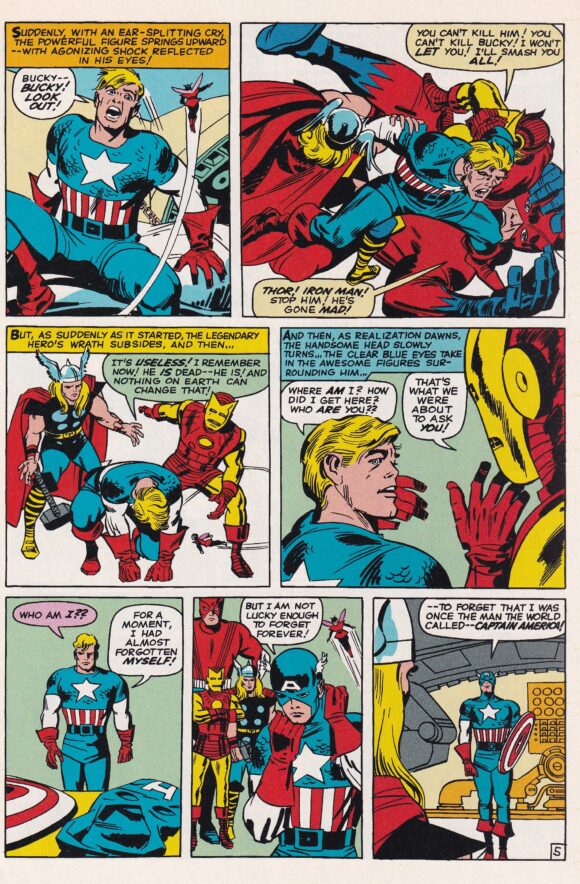
Since he’d been in suspended animation, I have no idea how he knew he’d been away for so long. But Cap quickly relays how he came to be in that state for 20 years: He explains that he and Bucky Barnes were stationed in Europe and their plane went down in the waters off the coast of Newfoundland. (That’s an incredibly remarkable feat considering the Canadian province is almost 2,800 miles from Europe. The Avengers were looking for a way to prove he wasn’t the real Cap, but never thought to question that.)

Anyway, they go back to Manhattan and an eager press awaits word of the Avengers finding the Hulk, not knowing the incredible news of who was still in their bathyscaphe. However, before Cap would emerge, the Avengers were turn – in a literally blinding flash – into stone statues by an alien who turned out to be the inspiration for the Medusa legend of myth. Not knowing the statues are the real Avengers, the press disperses and Cap comes out, thinking they left without him, so he goes exploring New York City.
A police officer who realizes he is the real Captain America directs him to a hotel, where he gets a room and drifts off to a troubled sleep. He suddenly wakes up and sees Rick Jones, the Avengers mascot, in the room. Steve Rogers thinks at first he is Bucky — and Rick thinks Steve is off his rocker, but quickly changes his mind.
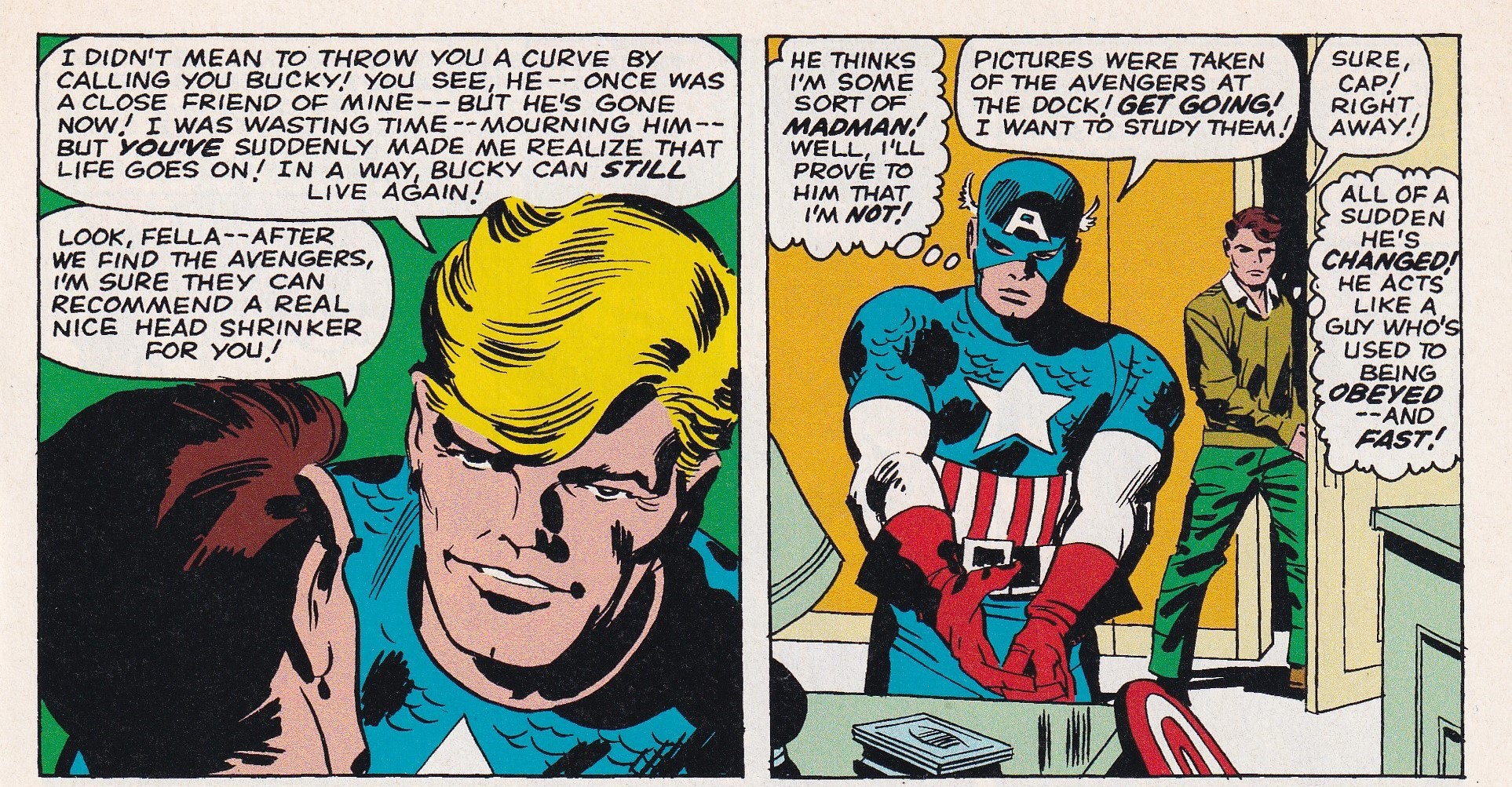
Together, along with Rick’s teenage brigade, Cap tracks down the alien, who tells him that he was under the orders of Namor, still ticked off at losing to the Avengers, and that Namor was holding the alien’s spacecraft by force under the waves. With the help of the restored-to-life Avengers, the ship is released, enraging Namor even more. He then sets himself and his undersea warriors in battle against the superhero team.
When the Sub-Mariner takes Jones prisoner, Cap leaps to his rescue. (Neither Cap nor Namor know each other, though they fought together during World War II. Another loose end.) The fight continues but Namor and his soldiers rush away when the island they are on starts falling apart, which is actually caused by the alien in his ship roaring up from the ocean’s bottom and returning to outer space. With peace restored, the Avengers ask Cap to join their team.

I was thoroughly hooked by Stan Lee and Jack Kirby (with inker George Roussos) returning the greatest hero of the 1940s’ Timely Comics era.
Cap’s adventures continued with the Avengers, and in Tales of Suspense #58 (Oct. 1964), Cap does battle with Iron Man, which was really just a preamble to the title splitting into two parts beginning in the following issue with the heroes having separate tales. I loved this, to say the least, with Jack Kirby continuing to draw both the winged Avenger’s stories set in the present and in the past.
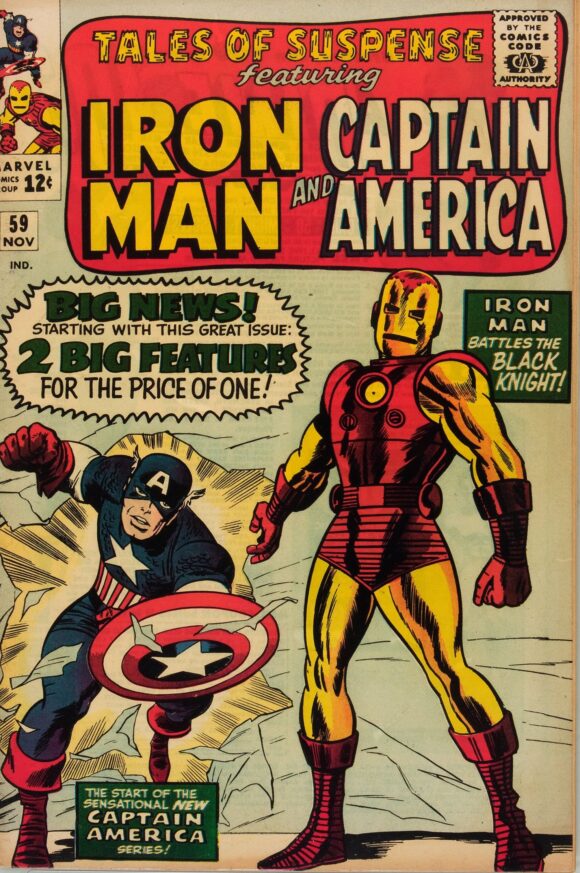
Marvel also put him into Sgt. Fury #13 (Dec. 1964) in an adventure set during WW II, with Bucky at his side.

Particularly memorable around this time was Tales of Suspense #63 (Mar. 1965), which featured “The Origin of Captain America.” (Just for fun, I have provided comparisons of Cap’s origin as depicted in Captain America Comics #1 (Mar. 1941) and in Tales of Suspense #63.)

(Left) Captain America Comics #1 (Mar. 1941) – Kirby and Joe Simon pencils, Simon inks. (Right) Tales of Suspense #63 (Mar. 1965). Kirby (Captain America) and Don Heck (Iron Man) pencils, Sol Brodsky (Captain America) and Ayers (Iron Man) inks.
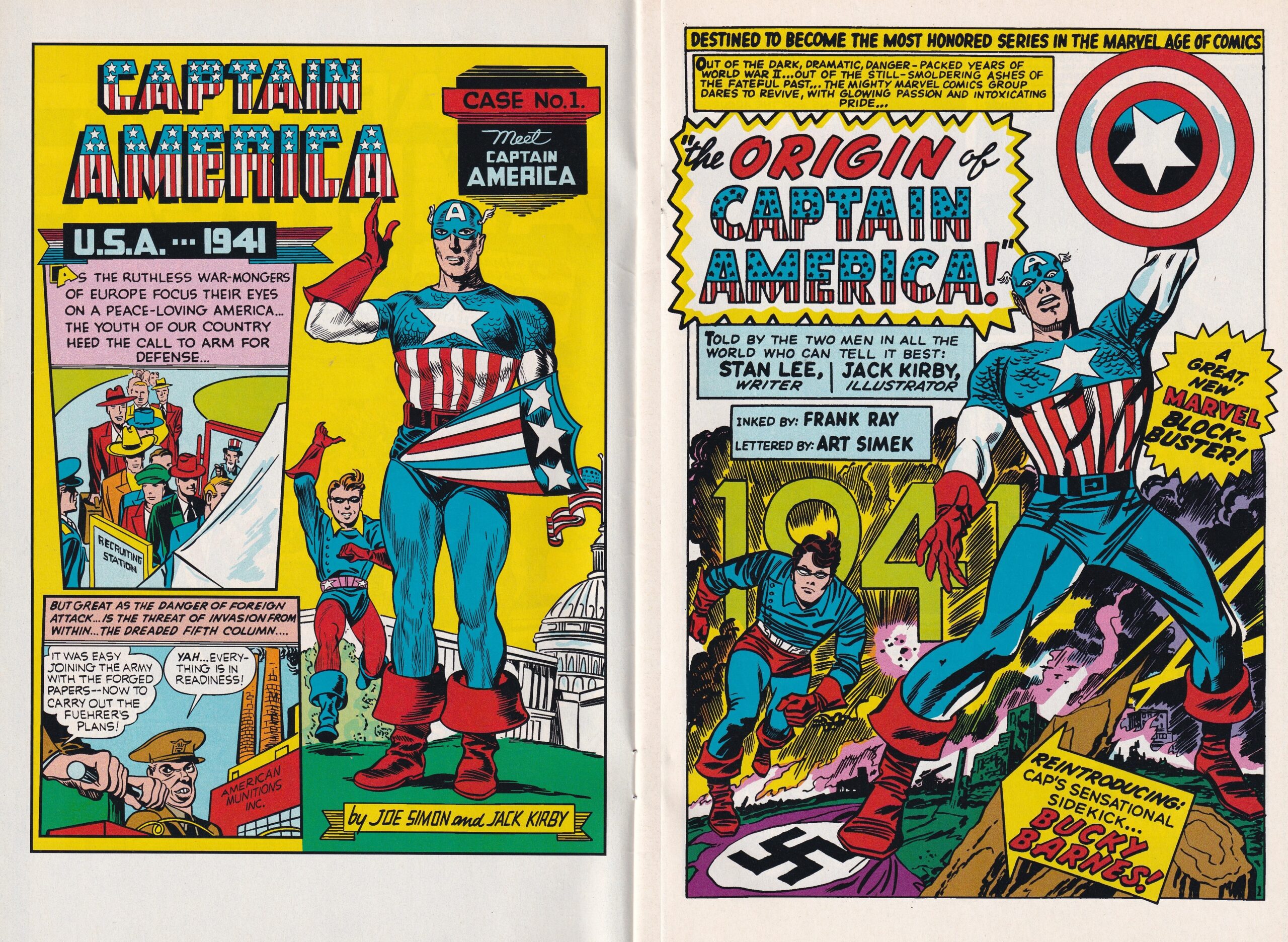
(Left) Captain America’s origin in Captain America Comics #1 (Mar. 1941) – Simon and Kirby script and pencils, Kirby inks. (Right) Tales of Suspense #63 (Mar. 1965) – Lee and Kirby script, Kirby pencils, Frank Giacoia inks.
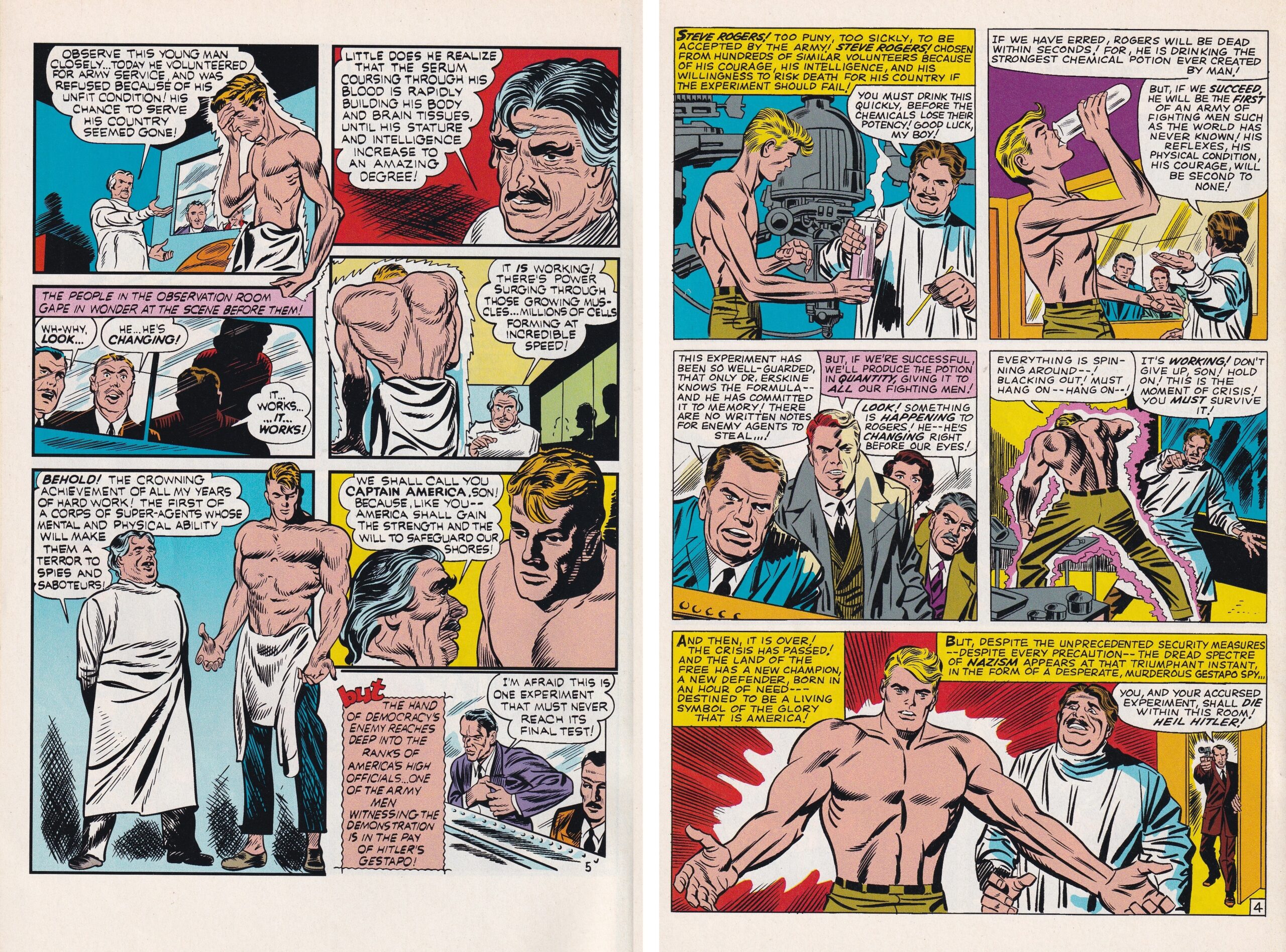
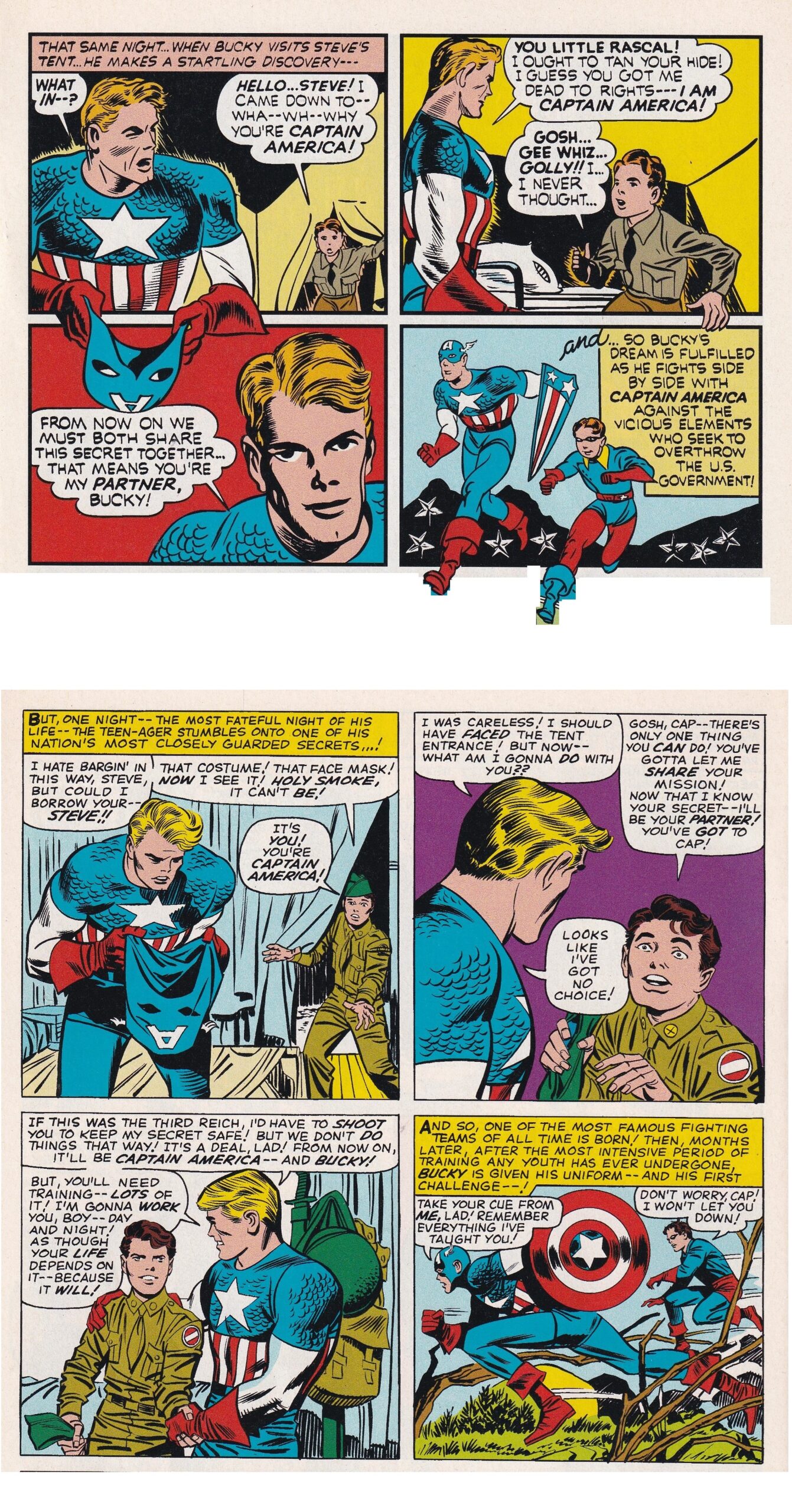

House ads from Captain America Comics #1 and Tales of Suspense #63
In my opinion, even after 60 years, out of all the thousands of comics Marvel has published since that time and all the heroes they have introduced (or re-introduced), the return of Steve Rogers’ Captain America remains the company’s finest moment.
—
MORE
— What if DC Published Marvel Characters in the ’60s: CAPTAIN AMERICA EDITION. Click here.
— Dig NEAL ADAMS’ Never-Published Inks Over GENE COLAN’s CAPTAIN AMERICA. Click here.
—
13th Dimension contributor-at-large PETER BOSCH’s first book, American TV Comic Books: 1940s-1980s – From the Small Screen to the Printed Page, was published by TwoMorrows. He is currently at work on a sequel, about movie comics. Peter has written articles and conducted celebrity interviews for various magazines and newspapers. He lives in Hollywood.


January 3, 2024
A classic comic that I’m happy to own.
January 3, 2024
Hang on to it, John H.!
Like Paul Bosch, I was the same age when Avengers No. 4 came out. I acquired it a couple of years later, most likely through an inexplicable trade. I was in AWE of that issue. It was my introduction to the entire cast (I was primarily a Batman/Flash reader). Apparently I failed to heed the plain-as-day Editor’s Note on the first page and that issue eventually got out of my possession. The panels posted here, however, are all burned into my memory like a brand. A Marvel brand, natch.
January 4, 2024
Still have my original copy.
January 4, 2024
Love this! So, how could that plane fly so far so fast? Well, how about it was an experimental model (in a world with a Human Torch and a Super-Soldier formula it isn’t too far a stretch!) Why didn’t Cap and Namor know each other? Remember, Namor had recently suffered from amnesia and Cap’s head was doubtlessly a little fogged after being on ice for two decades. And speaking of that, how could he survive being frozen without his blood vessels bursting? Credit the Super Soldier serum for that! And long live Cap!